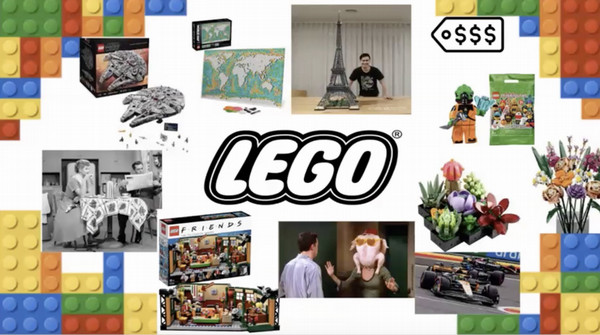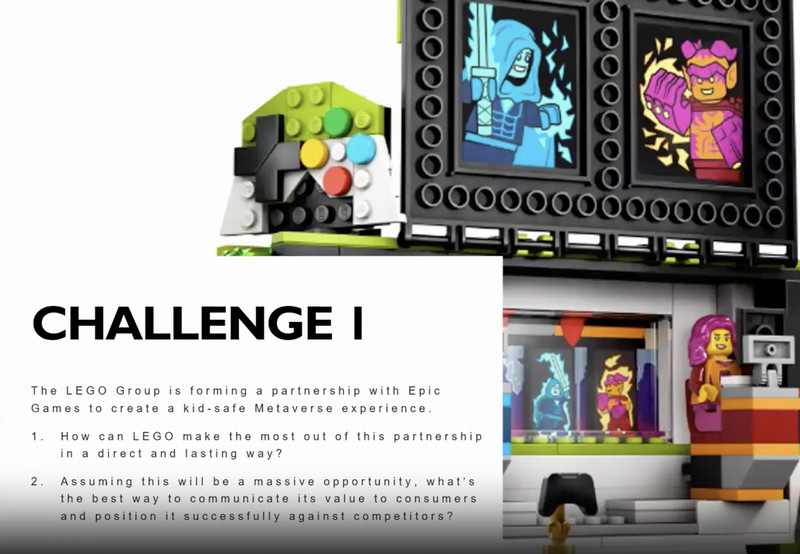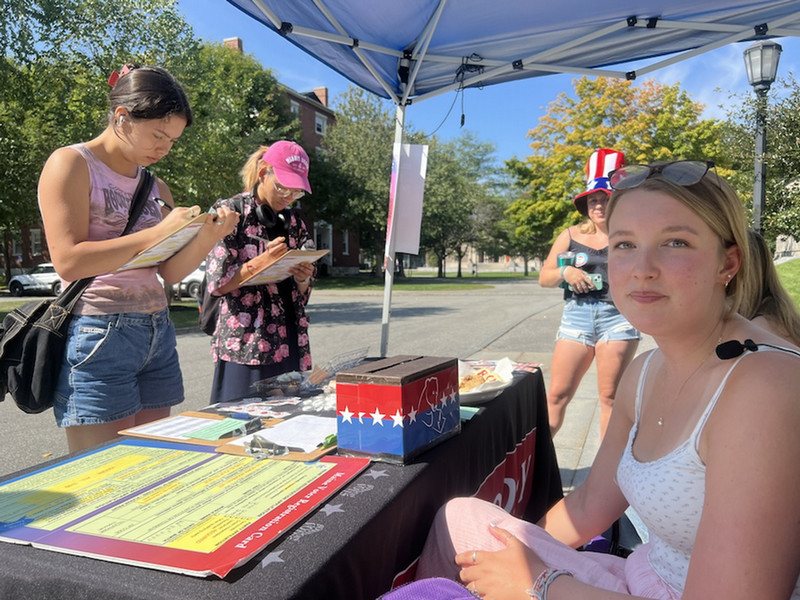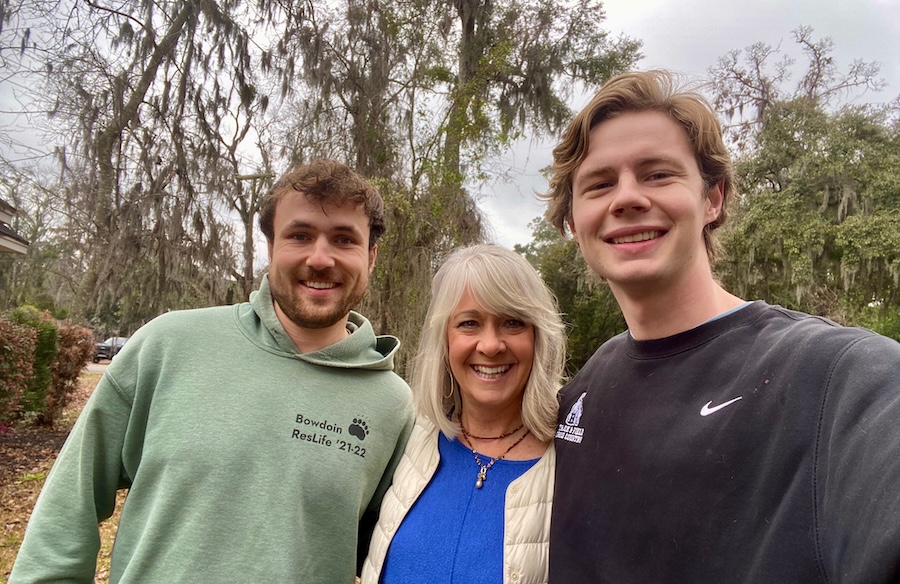Students Sharpen Business and Marketing Skills with Quick-Fire LEGO Challenge
By Tom PorterImagine you’re a LEGO executive faced with the following two tasks: how to work with an online gaming group to create an immersive, digital, and kid-safe experience and how to strengthen and grow the valuable adult consumer market.

The Mission
This is a challenge that many Bowdoin students probably don’t expect to be confronted with, but it was the question recently posed to fifty-eight of them who had signed up for the LEGO Quick-Fire Challenge.
The event was organized by Bowdoin’s Office of Career Exploration and Development (CXD) in conjunction with the Denmark-based global toy giant, famous for its interlocking plastic bricks.
Presenting the challenges, which the students were unaware of ahead of time, was Mike Moynihan ’89, senior vice president of marketing at the LEGO Group, who was also one of the three judges: the other two were Max Staiger ’13, who works in global brand management and strategy at Puma, and Bowdoin College Creative Director Janie Porche.
The first challenge went beyond the concept of LEGO as purely physical building blocks and into the digital sphere. Participants were asked how to use a recently established partnership with Epic Games (the developer of Fortnite) to devise a kid-safe metaverse experience. “The gaming metaverse, social media, and the internet more broadly are not really designed with kids in mind,” explained Moynihan—hence the need to develop a version that can be trusted by children and parents alike.
The second concerned LEGO’s adult consumers and how best to grow this increasingly valuable customer segment. “Adult consumers have become a really big part of our business,” he continued, “particularly within the last, probably, four or five years. It was accelerated, due to COVID.”
Students were divided into groups of four or five, each of which was assigned one of the challenges to work on. They then had two hours to brainstorm, strategize, and come up with a three-minute PowerPoint presentation in which they must all participate.


“This Quick-Fire Challenge is designed to give students of all ages, experience levels, and academic interests the chance to see how they can use their liberal arts skills to solve real world business challenges,” explained CXD Senior Associate Director Lisa Noble, who organized the event. “This involves bringing new products to market, entering new markets, refining their communication strategies to attract new customers. And what’s more,” she added, “they have just two hours to do this.”
Before the teams embarked on the Quick-Fire Challenge, Moynihan had the following words of advice: “At the end of the day, if the product is not actually delivering on something really cool and fun for consumers, then it's really not worthwhile. So that should definitely be your north star as you go through both of these challenges.”
“We were able to draw upon each of our own personal and educational experiences to tackle a problem that we had no prior knowledge of and very little time to solve. It really showcases how Bowdoin's liberal arts education prepares students to think critically, solve complex problems, and excel in collaborative environments.” Carlton Steinberg '24.
The Winners
“Our group proposed a LEGO metaverse in which users can create original builds online and compete in weekly challenges for the chance to win a physical set,” said Lexi Ashraf ’24, whose team won the prize for best presentation in how they tackled the first task. Teammate Julie Janssen ’26 explained: “Our metaverse game safely combines creativity, friendship, and fun and links it all to Epic, and most importantly, LEGO.”
Another team member was Emmanuel Nwodo ’27, one of the handful of incoming first-years who took part in the challenge. “This experience allowed my group to problem-solve, think outside the box, and collaborate. I definitely improved my ability to articulate myself, which was essential in coming up with our pitch,” said Nwodo.
Rising sophomore Mishra Shibali’s team earned the title of “most creative” for its approach to challenge number two, which asks how to grow the adult consumer market. “Our group aimed to honor the gift-giving tradition among adults, recognizing the challenges of finding meaningful presents as we grow older. With a focus on capturing the delight and surprise of receiving a personalized gift, we put forth the idea of LEGO offering a ‘Build Your Own LEGO Set’ service,” she said.
Teammate Carlton Steinberg ’24 was impressed with how well they all pulled together. “We were able to draw upon each of our own personal and educational experiences to tackle a problem that we had no prior knowledge of and very little time to solve. It really showcases how Bowdoin's liberal arts education prepares students to think critically, solve complex problems, and excel in collaborative environments.”
Laila Samuel ’27, Wilson Thors ’25, and Thors’s classmate Jess Klein were all members of the team awarded the “most collaborative” prize for how they tackled the first challenge. “We were challenged with creating a kid-friendly online game,” explained Samuel. “We pitched ‘LEGOverse,’ which would allow kids to use digital bricks to build and share creations with their friends. Kids would be able to scan real-life creations and put them into LEGOverse,” he explained, “as well as order the parts to assemble digital creations in real life.”

“LEGOverse would have both a semiprivate, invite-only realm option for friends, and a public forum where builders would compete for the leaderboards,” added Thors. “In both areas of this world, it would be possible to order a set and bring creations from virtual to reality (and vice versa), thus driving more physical sales for LEGO,” he added.
“This competition was great exposure to a realistic problem,” said Klein, “and collaboration with the team and feedback from the experienced judges were valuable.”
Great Effort!
After the prizes were announced, Moynihan said both he and his fellow judges were “blown away” by the efforts of all the teams in the Quick-Fire Challenge.
“The level of care and thought and care that was put in across the board was just super, super impressive. Some of the things we particularly called out were the degree to which people were focused on solving consumer problems and being very clear on what you’re trying to do. There was also a lot of creativity,” he added. The creativity prize was probably the toughest to decide, said Moynihan, “because a lot of people were really going outside the box and demonstrating some great imagination.”
All winning team members are to be awarded LEGO sets, said Noble, “most likely small ones, like the bonsai tree kits, so they can comfortably adorn their dorm rooms!” But the real prize, she added, is that “all these students have experiences that help inform the work they may want to do and have great stories to tell about their significant impact on the LEGO Group’s marketing challenge as a member of a student team!”



